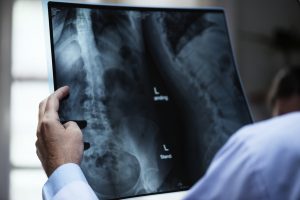‘Eat a balanced diet’. ‘Ensure a good work-life balance’. Balance your budget’. Notice a trend here? Balance seems to be considered a pretty important thing. Indeed it is, and perhaps nowhere as important as its role within our bodies. Without it, many of our basic motor functions get pretty damn difficult. Just ask anyone who’s suffered from Labyrinthitis, Benign Paroxysmal Positional Vertigo or Ménière’s Disease.
But even without suffering from one of those disorders, many of us struggle with poor balance. Our ability to balance is a combination of sight, vestibular (ear canals) and proprioception (our body’s ability to know where it is in space, even with our eyes closed). As we get older, our proprioceptive and vestibular systems decline, along with reflexes and coordination, resulting in diminished balance control. This is why so many elderly people fall down and break their hips or other bones. And that is one slippery slope we’d like to avoid!
So how to do that? Train your balance and coordination of course. The trusty old phrase ‘use it or lose it!’ applies here, I’m afraid. But the good news is that there are far more fun ways to train your balance than just standing on one foot. The brilliant folks at GMB recommend a programme consisting of jump spins, walking around with eyes closed (but shins beware!), as well as more advanced hand balancing techniques.
Here at Backs Etc., our training programmes often contain floor-based exercises that require a degree of balance control, as well as balance-challenging resistance exercises like single leg deadlifts and Bulgarian split squats. But one great tool that we’ve only recently started using is the slackline.

Similar to a tightrope, the slackline is stretched between two trees or other anchor points with the aim being to balance and walk along it. Unlike a tightrope, though, the slackline is a flat webbing, usually around 2 inches wide, making it easier to learn than a traditional tightrope. As the name implies, the slackline is not tensioned as tight as a tightrope. Because of this, the line moves up and down and side to side as you walk on it. The real skill then is to anticipate these slight movements of the line and move your body to compensate for them, improving your balance and core strength. Anybody first attempting to balance on a slackline will experience a violent shuddering back and forth of the line. This is due to the brain trying frantically to overcorrect the sideways motion of the line. This is similar to the way a driver may oversteer the opposite direction when skidding, causing a car to spin out of control. Fortunately, slacklining is much safer than driving!
So, besides improving our motor control and balance, what are some of the other benefits of slacklining?
It’s a full body workout. I mentioned core strength earlier, but slacklining requires the complete use of your entire body, engaging all your muscles and focus to prevent you from falling off the line.
It can boost memory function. A 2011 study in the scientific journal Hippocampus said, “slacklining led to an increase in the structural and functional plasticity of the hippocampus, an area of the brain responsible for navigation and memory”.
It can improve your posture, help you jump higher, and improve lower-limb rehabilitation.
It’s inexpensive. You can buy a good quality slackline for £30-£40.
It’s portable. Take it to the park and stretch it between two trees.
It’s fun! (need I say more?)
It’s worth noting that slacklining is pretty challenging. I’ve been using ours for about a month or so and I’m still pretty bad. But I notice little improvements regularly, and that feels nice. It’s also encouraging knowing that every time I step on it, I’m making positive changes for my body and mind. Being a slacker has never felt so good!
 Weightlifting as a form of exercise has been growing in popularity, and for good reason. But many people still believe that, for heart health, cardio workouts are superior. New research has found, however, that lifting weights can be healthier for the heart than going for a run or a walk.
Weightlifting as a form of exercise has been growing in popularity, and for good reason. But many people still believe that, for heart health, cardio workouts are superior. New research has found, however, that lifting weights can be healthier for the heart than going for a run or a walk.
 Acetaminophen, most commonly known as Tylenol, is one of the most popular over-the-counter painkillers. Most people don’t think twice about taking it for the occasional ache or pain. Yet acetaminophen may be one of the most dangerous medicines in the drugstore. In this article, functional medicine practitioner Chris Kresser discusses the potential liver toxicity of the drug, as well as its negative effects on cardiovascular health, kidney disease, and even cancer.
Acetaminophen, most commonly known as Tylenol, is one of the most popular over-the-counter painkillers. Most people don’t think twice about taking it for the occasional ache or pain. Yet acetaminophen may be one of the most dangerous medicines in the drugstore. In this article, functional medicine practitioner Chris Kresser discusses the potential liver toxicity of the drug, as well as its negative effects on cardiovascular health, kidney disease, and even cancer. This article from The Weston A. Price Foundation takes aim at one of our most popular cooking oils, canola. The food industry has been lauding the benefits of canola oil since its arrival on the scene in the mid-1980s, calling it ‘heart healthy’, ‘high in Omega 3s’ and ‘widely recognized as the healthiest salad and cooking oil available to consumers.’ However, there is a dark side to canola oil, as studies have shown it to actually be potentially dangerous to humans. This article details the history of the oil and documents the health risks associated with canola and other industrial seed oils.
This article from The Weston A. Price Foundation takes aim at one of our most popular cooking oils, canola. The food industry has been lauding the benefits of canola oil since its arrival on the scene in the mid-1980s, calling it ‘heart healthy’, ‘high in Omega 3s’ and ‘widely recognized as the healthiest salad and cooking oil available to consumers.’ However, there is a dark side to canola oil, as studies have shown it to actually be potentially dangerous to humans. This article details the history of the oil and documents the health risks associated with canola and other industrial seed oils. Aging, there’s no way to avoid it. But there are many ways that we can mitigate its negative effects. In this article, our friends at
Aging, there’s no way to avoid it. But there are many ways that we can mitigate its negative effects. In this article, our friends at  Veganism is becoming more and more popular these days. Understandably so, as people are becoming increasingly concerned about the impact of Intensively farmed meat and dairy’s toll on the environment. However, in this article, farmer Isabella Tree discusses the potential negative implications that veganism can have on the sustainability of our farmland, as well as our health. This article is a great read no matter which side of the debate you may stand on.
Veganism is becoming more and more popular these days. Understandably so, as people are becoming increasingly concerned about the impact of Intensively farmed meat and dairy’s toll on the environment. However, in this article, farmer Isabella Tree discusses the potential negative implications that veganism can have on the sustainability of our farmland, as well as our health. This article is a great read no matter which side of the debate you may stand on. Neurokinetic Therapy. If you’ve been to see us at Backs Etc., you’ve probably heard this phrase. NKT, as it’s known for short, is an innovative technique which utilises manual muscle testing to assess dysfunctions in the coordination system of the brain that can result from injury, postural stress or poor movement patterns. It cues the brain for new learning resulting in immediate correction of neuromuscular imbalances. NKT addresses pain at its source: the motor control centre of the brain.
Neurokinetic Therapy. If you’ve been to see us at Backs Etc., you’ve probably heard this phrase. NKT, as it’s known for short, is an innovative technique which utilises manual muscle testing to assess dysfunctions in the coordination system of the brain that can result from injury, postural stress or poor movement patterns. It cues the brain for new learning resulting in immediate correction of neuromuscular imbalances. NKT addresses pain at its source: the motor control centre of the brain.

 The get-up, sometimes referred to as the Turkish get-up is one of the most effective full-body resistance exercises one can do. A few years ago it was all the rage. Lately, for some reason, it seems to have fallen a little out of favour. In this article from StrongFirst, the author discusses how get-ups are a natural evolution from crawling, another form of exercise that has become hugely popular of late (and for good reason!). Both crawling and get-ups can be extremely beneficial for strength, stability and mobility, as well as for the vestibular, visual and proprioceptive systems.
The get-up, sometimes referred to as the Turkish get-up is one of the most effective full-body resistance exercises one can do. A few years ago it was all the rage. Lately, for some reason, it seems to have fallen a little out of favour. In this article from StrongFirst, the author discusses how get-ups are a natural evolution from crawling, another form of exercise that has become hugely popular of late (and for good reason!). Both crawling and get-ups can be extremely beneficial for strength, stability and mobility, as well as for the vestibular, visual and proprioceptive systems. A summary of the evidence on the reliability of scans for musculoskeletal issues, showing that in most cases there are just any many people with structural issues that don’t have pain and dysfunction. It’s not how it looks, but how it works that is important, that’s why at Backs Etc we focus on improving movement patterns.
A summary of the evidence on the reliability of scans for musculoskeletal issues, showing that in most cases there are just any many people with structural issues that don’t have pain and dysfunction. It’s not how it looks, but how it works that is important, that’s why at Backs Etc we focus on improving movement patterns.